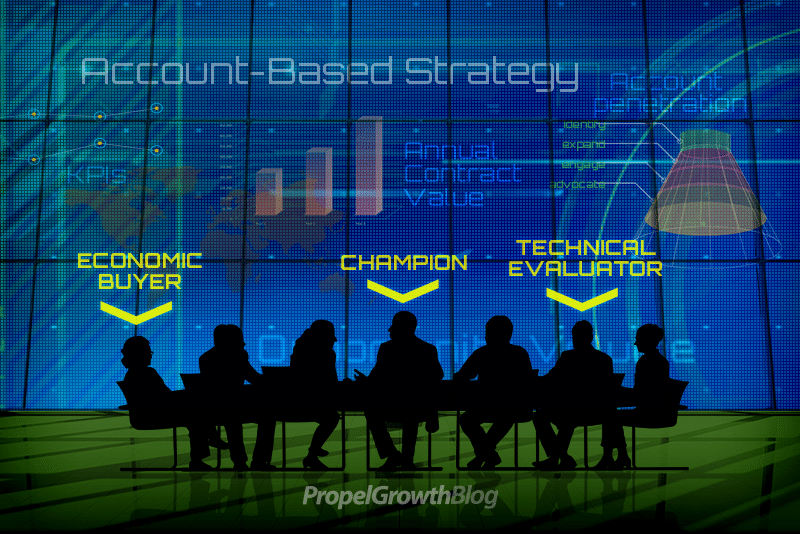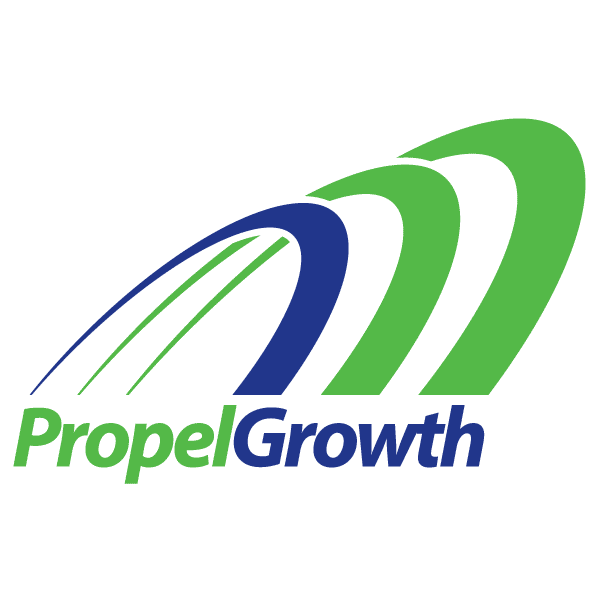
Account-based marketing and sales strategies deliver a 171% uplift in annual contract value (ACV) according to TOPO research published in Q4 2016. These strategies consistently outperform traditional marketing methods for firms that sell to large enterprise accounts or have a high lifetime customer value.
What Is an Account-Based Strategy?
In complex B2B sales, there is almost never one individual buyer. Purchasing decisions are made by committees. So it does not make sense to target these accounts at the lead level.
Account-based marketing essentially leverages and supports strategies long used by Sales for targeting strategic or enterprise accounts. It’s a highly customer-centric method to gain access, generate opportunities, and expand reach in key accounts.
This is often referred to as Account-Based Marketing (ABM) or Account Based Everything (ABE). I prefer to refer to it as “account-based strategy” or ABE because these strategies should not be deployed exclusively in marketing. It requires close coordination between Sales, Marketing and all other customer touch points.
Since “ABM” gets the most “Google Love,” I’m using that term in this article for SEO purposes. But really, we should call it ABE or account-based strategy.
This Is an Enterprise Strategy
When I talk about ABM or ABE, I’m talking about a coordinated, personalized approach to target specific accounts. This is not something that you do at scale, and it requires a substantial investment in sales and marketing resources. So it’s only useful for accounts where the likely annual contract value (ACV) exceeds $200K US and lifetime customer value (LCV) exceeds $500K. An account-based strategy is too expensive to deploy for smaller accounts.
Can an Account-Based Marketing Strategy Scale?
There are “thought leaders,” particularly software providers, who pitch ABM at scale (targeting 100s and 1000s of accounts at once). But I’d posit that these are really niche marketing strategies, not true ABM. So if your business strategy is focused on high volume of small tickets, then this blog post (and this strategy) is not going to be relevant to you.
5 Attributes of Account-Based Strategy
At the TOPO summit in April 2017, Craig Rosenberg presented 5 attributes of account-based strategy.
- Targeted, high value accounts. The accounts selected must meet minimum customer lifetime values and be strategically important.
- Orchestration across organization. ABM is primarily an outbound strategy and demands orchestration across every customer touch point including marketing, advertising, PR, SDRs, sales people, sales engineers, customer support and the executive team.
- Intelligence-driven campaigns. You must have deep insights about the target accounts to inform your campaigns. You’ll also need analytics to observe response rates and track your progress.
- Valuable and personalized experiences. The content of the campaigns needs to be directly relevant to the account, leveraging account-specific insights and research.
- Coordinated, high effort/high frequency outreach. This strategy works best when multiple roles in the target account are reached by similar roles in the seller’s organization, and when coordinated with key marketing events.
Account Selection Strategy
The first key to a successful account-based strategy is selecting the right key accounts to target. This starts with a very rigorous ideal customer profile (ICP). Craig Rosenberg from TOPO and I talked about how to create an ICP in this recent podcast.
Choose key accounts with substantial lifetime client value (LCV). These accounts should be strategically important, have potential for substantial ongoing revenue and account expansion, and be an ideal fit for your products and/or services.
This is not a volume strategy. I’d recommend that you start with no more than 5 key target accounts. You can be opportunistic, but if your targets are too broad, the strategy will be more expensive to deploy. It’s easier to select 5 accounts that are in similar vertical niches and have similar needs/goals.
If you need to satisfy lots of sales people, look for volunteers who are excited to collaborate closely with marketing to target key accounts. Run a pilot with them before you expand this approach more broadly.
Options to consider when picking the accounts include:
- High yield
- Product fit
- Strategic importance
ABM Requires Coordination Across the Organization
ABM (or ABE) is not just Marketing’s job. Interdepartmental alignment is crucial to the success of an account-based strategy. It requires coordination between corporate and field marketing, PR, advertising, SDRs, field sales, customer support, product management, and even the executive team.
You will need to closely integrate your online and offline efforts to present a consistent, personalized, and account-specific face to the target audience. If you try to limit your account-based strategy to the marketing department, it will not be as effective.
Account-Based, Insight-Driven Campaigns
ABM campaigns need intelligence in 3 key areas:
- Account insights and intelligence for creating targeted content. Successful ABM strategists invest in researching the key accounts to uncover their business goals and likely pain points and needs. Then they create content directly related to those specific insights. Some firms invest as much as 7-10 hours researching a single account in order to develop the account-specific content and strategy.
- Complete contact data for all the target buyer personas and likely members of the selection committee. Contact data is a struggle for most companies, but it’s crucial to make sure you have up-to-date contacts for the accounts being targeted.
- Analytics for tracking responses and progress. Marketing and sales automation platforms don’t do a great job of tracking at the account level. There are several good ABM tools on the market, but they’re expensive, and they may not integrate with your existing marketing and CRM technology. So start by tracking results manually. Make sure that your contacts are tagged with the right accounts in your marketing automation platform and your CRM. Then develop custom reporting methods to track at the account level. I recommend holding off on evaluating account-based automation tools until you run a couple successful pilot campaigns. Then you’ll have a better idea of what capabilities you need.
Score Engagement at the Account Level
Traditional marketing is focused on volume – numbers of impressions, open rates, conversions, numbers of net new leads generated. But tracking at the contact level is not a good indicator of a qualified account.
In an account-based strategy, it’s not about volume, it’s about getting a response from the right people. For example, let’s say you do a targeted webinar that is specific to the needs of 3 key accounts. If you get only 15 to 20 attendees, but they’re the right people from the 3 accounts, then that webinar should be counted as a smashing success.
“Don’t count the people you reach; reach the people who count.” ~David Olgilvy
So apply scoring at the account level, not individual leads. The more contacts you have engaged in an account, the better the account score. This is not about volume, it’s about account engagement. For example, one contact at Deutsche Bank who opens all your emails and visited 15 pages on your website is not nearly as valuable as the 6 different contacts at Bank of America who each viewed 2-3 web pages and attended a targeted webinar.
Use the Right Attribution Models
Don’t assume that Marketing will be the original source of the leads. In fact, if you’re picking the right ideal accounts, it’s likely that several people in your organization already have connections in the account. So normal attribution models won’t work. Measure account influence, access to buying committee members and cross-account expansion, not lead sourcing.
Develop Personalized Campaigns Based on Insights
The more personalized the campaign and content, the more effective it will be. These accounts are valuable enough to make it worthwhile to go the extra mile. So develop content that is customized to the account’s specific goals, challenges and needs. Firms are seeing more ABM success when they develop highly customized offers based on their research.
In my next post, I’ll go deeper into HOW to implement account-based strategies including details on how firms have achieved success with ABM. Here’s a case study on how we approached account-based marketing for a FinTech firm.
If you’d like to talk about whether ABM might work for your firm, email me to schedule a call. I’m happy to explore options with you.
You can also check out this related content about Account Based Marketing and Sales:
Article: Is Account-Based Marketing Right for Your Company?
Article: Account-Based Marketing for Investment Management Marketers
Article: How to Implement an Account Based Strategy
Article: Account-Based Selling and How It Can Help Your Sales Team
Guest Post: Five Levels of Account-Based Orchestration
Guest Post: How to Plan and Scale Account Based Marketing Interactions
Podcast: An Ideal Customer Profile with Craig Rosenberg
Podcast: Scaling Up Sales Growth with Account-Based Strategies
- 4 Steps to Optimize Your LinkedIn Profile for Sales Prospecting – February 12, 2021
- The Reality of Cold Calling for B2B Sales – January 11, 2021
- Can Inbound Marketing Generate Enough Leads? – January 9, 2021






